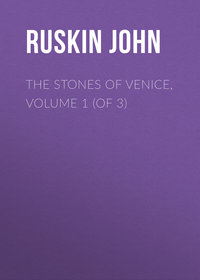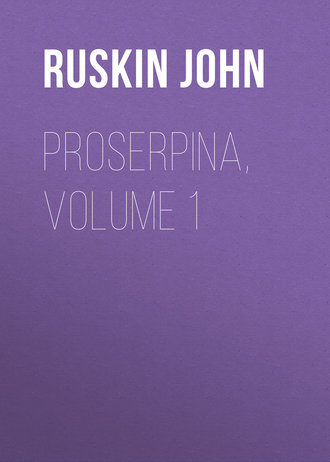 полная версия
полная версияProserpina, Volume 1
26. So that you must not attach any great botanical importance to the characters of contrasted aspects in leaves, which I wish you to express by the words 'Apolline' and 'Arethusan'; but their mythic importance is very great, and your careful observance of it will help you completely to understand the beautiful Greek fable of Apollo and Daphne. There are indeed several Daphnes, and the first root of the name is far away in another field of thought altogether, connected with the Gods of Light. But etymology, the best of servants, is an unreasonable master; and Professor Max Müller trusts his deep-reaching knowledge of the first ideas connected with the names of Athena and Daphne, too implicitly, when he supposes this idea to be retained in central Greek theology. 'Athena' originally meant only the dawn, among nations who knew nothing of a Sacred Spirit. But the Athena who catches Achilles by the hair, and urges the spear of Diomed, has not, in the mind of Homer, the slightest remaining connection with the mere beauty of daybreak. Daphne chased by Apollo, may perhaps—though I doubt even this much of consistence in the earlier myth—have meant the Dawn pursued by the Sun. But there is no trace whatever of this first idea left in the fable of Arcadia and Thessaly.
27. The central Greek Daphne is the daughter of one of the great river gods of Arcadia; her mother is the Earth. Now Arcadia is the Oberland of Greece; and the crests of Cyllene, Erymanthus, and Mænalus21 surround it, like the Swiss forest cantons, with walls of rock, and shadows of pine. And it divides itself, like the Oberland, into three regions: first, the region of rock and snow, sacred to Mercury and Apollo, in which Mercury's birth on Cyllene, his construction of the lyre, and his stealing the oxen of Apollo, are all expressions of the enchantments of cloud and sound, mingling with the sunshine, on the cliffs of Cyllene.
"While the mistsFlying, and rainy vapours, call out shapesAnd phantoms from the crags and solid earthAs fast as a musician scatters soundsOut of his instrument."Then came the pine region, sacred especially to Pan and Mænalus, the son of Lycaon and brother of Callisto; and you had better remember this relationship carefully, for the sake of the meaning of the constellations of Ursa Major and the Mons Mænalius, and of their wolf and bear traditions; (compare also the strong impression on the Greek mind of the wild leafiness, nourished by snow, of the Bœotian Cithæron,—"Oh, thou lake-hollow, full of divine leaves, and of wild creatures, nurse of the snow, darling of Diana," (Phœnissæ, 801)). How wild the climate of this pine region is, you may judge from the pieces in the note below22 out of Colonel Leake's diary in crossing the Mænalian range in spring. And then, lastly, you have the laurel and vine region, full of sweetness and Elysian beauty.
28. Now as Mercury is the ruling power of the hill enchantment, so Daphne of the leafy peace. She is, in her first life, the daughter of the mountain river, the mist of it filling the valley; the Sun, pursuing, and effacing it, from dell to dell, is, literally, Apollo pursuing Daphne, and adverse to her; (not, as in the earlier tradition, the Sun pursuing only his own light). Daphne, thus hunted, cries to her mother, the Earth, which opens, and receives her, causing the laurel to spring up in her stead. That is to say, wherever the rocks protect the mist from the sunbeam, and suffer it to water the earth, there the laurel and other richest vegetation fill the hollows, giving a better glory to the sun itself. For sunshine, on the torrent spray, on the grass of its valley, and entangled among the laurel stems, or glancing from their leaves, became a thousandfold lovelier and more sacred than the same sunbeams, burning on the leafless mountain-side.
And farther, the leaf, in its connection with the river, is typically expressive, not, as the flower was, of human fading and passing away, but of the perpetual flow and renewal of human mind and thought, rising "like the rivers that run among the hills"; therefore it was that the youth of Greece sacrificed their hair—the sign of their continually renewed strength,—to the rivers, and to Apollo. Therefore, to commemorate Apollo's own chief victory over death—over Python, the corrupter,—a laurel branch was gathered every ninth year in the vale of Tempe; and the laurel leaf became the reward or crown of all beneficent and enduring work of man—work of inspiration, born of the strength of the earth, and of the dew of heaven, and which can never pass away.
29. You may doubt at first, even because of its grace, this meaning in the fable of Apollo and Daphne; you will not doubt it, however, when you trace it back to its first eastern origin. When we speak carelessly of the traditions respecting the Garden of Eden, (or in Hebrew, remember, Garden of Delight,) we are apt to confuse Milton's descriptions with those in the book of Genesis. Milton fills his Paradise with flowers; but no flowers are spoken of in Genesis. We may indeed conclude that in speaking of every herb of the field, flowers are included. But they are not named. The things that are named in the Garden of Delight are trees only.
The words are, "every tree that was pleasant to the sight and good for food;" and as if to mark the idea more strongly for us in the Septuagint, even the ordinary Greek word for tree is not used, but the word ξυλον,—literally, every 'wood,' every piece of timber that was pleasant or good. They are indeed the "vivi travi,"—living rafters, of Dante's Apennine.
Do you remember how those trees were said to be watered? Not by the four rivers only. The rivers could not supply the place of rain. No rivers do; for in truth they are the refuse of rain. No storm-clouds were there, nor hidings of the blue by darkening veil; but there went up a mist from the earth, and watered the face of the ground,—or, as in Septuagint and Vulgate, "There went forth a fountain from the earth, and gave the earth to drink."
30. And now, lastly, we continually think of that Garden of Delight, as if it existed, or could exist, no longer; wholly forgetting that it is spoken of in Scripture as perpetually existent; and some of its fairest trees as existent also, or only recently destroyed. When Ezekiel is describing to Pharaoh the greatness of the Assyrians, do you remember what image he gives of them? "Behold, the Assyrian was a cedar in Lebanon, with fair branches; and his top was among the thick boughs; the waters nourished him, and the deep brought him up, with her rivers running round about his plants. Under his branches did all the beasts of the field bring forth their young; and under his shadow dwelt all great nations."
31. Now hear what follows. "The cedars in the Garden of God could not hide him. The fir trees were not like his boughs, and the chestnut trees were not like his branches; nor any tree in the Garden of God was like unto him in beauty."
So that you see, whenever a nation rises into consistent, vital, and, through many generations, enduring power, there is still the Garden of God; still it is the water of life which feeds the roots of it; and still the succession of its people is imaged by the perennial leafage of trees of Paradise. Could this be said of Assyria, and shall it not be said of England? How much more, of lives such as ours should be,—just, laborious, united in aim, beneficent in fulfilment, may the image be used of the leaves of the trees of Eden! Other symbols have been given often to show the evanescence and slightness of our lives—the foam upon the water, the grass on the housetop, the vapour that vanishes away; yet none of these are images of true human life. That life, when it is real, is not evanescent; is not slight; does not vanish away. Every noble life leaves the fibre of it interwoven for ever in the work of the world; by so much, evermore, the strength of the human race has gained; more stubborn in the root, higher towards heaven in the branch; and, "as a teil tree, and as an oak,—whose substance is in them when they cast their leaves,—so the holy seed is in the midst thereof."
32. Only remember on what conditions. In the great Psalm of life, we are told that everything that a man doeth shall prosper, so only that he delight in the law of his God, that he hath not walked in the counsel of the wicked, nor sat in the seat of the scornful. Is it among these leaves of the perpetual Spring,—helpful leaves for the healing of the nations,—that we mean to have our part and place, or rather among the "brown skeletons of leaves that lag, the forest brook along"? For other leaves there are, and other streams that water them,—not water of life, but water of Acheron. Autumnal leaves there are that strew the brooks, in Vallombrosa. Remember you how the name of the place was changed: "Once called 'Sweet water' (Aqua bella), now, the Shadowy Vale." Portion in one or other name we must choose, all of us,—with the living olive, by the living fountains of waters, or with the wild fig trees, whose leafage of human soul is strewed along the brooks of death, in the eternal Vallombrosa.
CHAPTER IV.
THE FLOWER
Rome, Whit Monday, 1874.1. On the quiet road leading from under the Palatine to the little church of St. Nereo and Achilleo, I met, yesterday morning, group after group of happy peasants heaped in pyramids on their triumphal carts, in Whit-Sunday dress, stout and clean, and gay in colour; and the women all with bright artificial roses in their hair, set with true natural taste, and well becoming them. This power of arranging wreath or crown of flowers for the head, remains to the people from classic times. And the thing that struck me most in the look of it was not so much the cheerfulness, as the dignity;—in a true sense, the becomingness and decorousness of the ornament. Among the ruins of the dead city, and the worse desolation of the work of its modern rebuilders, here was one element at least of honour, and order;—and, in these, of delight.
And these are the real significances of the flower itself. It is the utmost purification of the plant, and the utmost discipline. Where its tissue is blanched fairest, dyed purest, set in strictest rank, appointed to most chosen office, there—and created by the fact of this purity and function—is the flower.
2. But created, observe, by the purity and order, more than by the function. The flower exists for its own sake,—not for the fruit's sake. The production of the fruit is an added honour to it—is a granted consolation to us for its death. But the flower is the end of the seed,—not the seed of the flower. You are fond of cherries, perhaps; and think that the use of cherry blossom is to produce cherries. Not at all. The use of cherries is to produce cherry blossoms; just as the use of bulbs is to produce hyacinths,—not of hyacinths to produce bulbs. Nay, that the flower can multiply by bulb, or root, or slip, as well as by seed, may show you at once how immaterial the seed-forming function is to the flower's existence. A flower is to the vegetable substance what a crystal is to the mineral. "Dust of sapphire," writes my friend Dr. John Brown to me, of the wood hyacinths of Scotland in the spring. Yes, that is so,—each bud more beautiful, itself, than perfectest jewel—this, indeed, jewel "of purest ray serene;" but, observe you, the glory is in the purity, the serenity, the radiance,—not in the mere continuance of the creature.
3. It is because of its beauty that its continuance is worth Heaven's while. The glory of it is in being,—not in begetting; and in the spirit and substance,—not the change. For the earth also has its flesh and spirit. Every day of spring is the earth's Whit Sunday—Fire Sunday. The falling fire of the rainbow, with the order of its zones, and the gladness of its covenant,—you may eat of it, like Esdras; but you feed upon it only that you may see it. Do you think that flowers were born to nourish the blind?
Fasten well in your mind, then, the conception of order, and purity, as the essence of the flower's being, no less than of the crystal's. A ruby is not made bright to scatter round it child-rubies; nor a flower, but in collateral and added honour, to give birth to other flowers.
Two main facts, then, you have to study in every flower: the symmetry or order of it, and the perfection of its substance; first, the manner in which the leaves are placed for beauty of form; then the spinning and weaving and blanching of their tissue, for the reception of purest colour, or refining to richest surface.
4. First, the order: the proportion, and answering to each other, of the parts; for the study of which it becomes necessary to know what its parts are; and that a flower consists essentially of—Well, I really don't know what it consists essentially of. For some flowers have bracts, and stalks, and toruses, and calices, and corollas, and discs, and stamens, and pistils, and ever so many odds and ends of things besides, of no use at all, seemingly; and others have no bracts, and no stalks, and no toruses, and no calices, and no corollas, and nothing recognizable for stamens or pistils,—only, when they come to be reduced to this kind of poverty, one doesn't call them flowers; they get together in knots, and one calls them catkins, or the like, or forgets their existence altogether;—I haven't the least idea, for instance, myself, what an oak blossom is like; only I know its bracts get together and make a cup of themselves afterwards, which the Italians call, as they do the dome of St. Peter's, 'cupola'; and that it is a great pity, for their own sake as well as the world's, that they were not content with their ilex cupolas, which were made to hold something, but took to building these big ones upside-down, which hold nothing—less than nothing,—large extinguishers of the flame of Catholic religion. And for farther embarrassment, a flower not only is without essential consistence of a given number of parts, but it rarely consists, alone, of itself. One talks of a hyacinth as of a flower; but a hyacinth is any number of flowers. One does not talk of 'a heather'; when one says 'heath,' one means the whole plant, not the blossom,—because heath-bells, though they grow together for company's sake, do so in a voluntary sort of way, and are not fixed in their places; and yet, they depend on each other for effect, as much as a bunch of grapes.
5. And this grouping of flowers, more or less waywardly, is the most subtle part of their order, and the most difficult to represent. Take that cluster of bog-heather bells, for instance, Line-study 1. You might think at first there were no lines in it worth study; but look at it more carefully. There are twelve bells in the cluster. There may be fewer, or more; but the bog-heath is apt to run into something near that number. They all grow together as close as they can, and on one side of the supporting branch only. The natural effect would be to bend the branch down; but the branch won't have that, and so leans back to carry them. Now you see the use of drawing the profile in the middle figure: it shows you the exactly balanced setting of the group,—not drooping, nor erect; but with a disposition to droop, tossed up by the leaning back of the stem. Then, growing as near as they can to each other, those in the middle get squeezed. Here is another quite special character. Some flowers don't like being squeezed at all (fancy a squeezed convolvulus!); but these heather bells like it, and look all the prettier for it,—not the squeezed ones exactly, by themselves, but the cluster altogether, by their patience.
Then also the outside ones get pushed into a sort of star-shape, and in front show the colour of all their sides, and at the back the rich green cluster of sharp leaves that hold them; all this order being as essential to the plant as any of the more formal structures of the bell itself.
6. But the bog-heath has usually only one cluster of flowers to arrange on each branch. Take a spray of ling (Frontispiece), and you will find that the richest piece of Gothic spire-sculpture would be dull and graceless beside the grouping of the floral masses in their various life. But it is difficult to give the accuracy of attention necessary to see their beauty without drawing them; and still more difficult to draw them in any approximation to the truth before they change. This is indeed the fatallest obstacle to all good botanical work. Flowers, or leaves,—and especially the last,—can only be rightly drawn as they grow. And even then, in their loveliest spring action, they grow as you draw them, and will not stay quite the same creatures for half an hour.
7. I said in my inaugural lectures at Oxford, § 107, that real botany is not so much the description of plants as their biography. Without entering at all into the history of its fruitage, the life and death of the blossom itself is always an eventful romance, which must be completely told, if well. The grouping given to the various states of form between bud and flower is always the most important part of the design of the plant; and in the modes of its death are some of the most touching lessons, or symbolisms, connected with its existence. The utter loss and far-scattered ruin of the cistus and wild rose,—the dishonoured and dark contortion of the convolvulus,—the pale wasting of the crimson heath of Apennine, are strangely opposed by the quiet closing of the brown bells of the ling, each making of themselves a little cross as they die; and so enduring into the days of winter. I have drawn the faded beside the full branch, and know not which is the more beautiful.
8. This grouping, then, and way of treating each other in their gathered company, is the first and most subtle condition of form in flowers; and, observe, I don't mean, just now, the appointed and disciplined grouping, but the wayward and accidental. Don't confuse the beautiful consent of the cluster in these sprays of heath with the legal strictness of a foxglove,—though that also has its divinity; but of another kind. That legal order of blossoming—for which we may wisely keep the accepted name, 'inflorescence,'—is itself quite a separate subject of study, which we cannot take up until we know the still more strict laws which are set over the flower itself.
9. I have in my hand a small red poppy which I gathered on Whit Sunday on the palace of the Cæsars. It is an intensely simple, intensely floral, flower. All silk and flame: a scarlet cup, perfect-edged all round, seen among the wild grass far away, like a burning coal fallen from Heaven's altars. You cannot have a more complete, a more stainless, type of flower absolute; inside and outside, all flower. No sparing of colour anywhere—no outside coarsenesses—no interior secrecies; open as the sunshine that creates it; fine-finished on both sides, down to the extremest point of insertion on its narrow stalk; and robed in the purple of the Cæsars.
Literally so. That poppy scarlet, so far as it could be painted by mortal hand, for mortal King, stays yet, against the sun, and wind, and rain, on the walls of the house of Augustus, a hundred yards from the spot where I gathered the weed of its desolation.
10. A pure cup, you remember it is; that much at least you cannot but remember, of poppy-form among the cornfields; and it is best, in beginning, to think of every flower as essentially a cup. There are flat ones, but you will find that most of these are really groups of flowers, not single blossoms; and there are out-of-the-way and quaint ones, very difficult to define as of any shape; but even these have a cup to begin with, deep down in them. You had better take the idea of a cup or vase, as the first, simplest, and most general form of true flower.
The botanists call it a corolla, which means a garland, or a kind of crown; and the word is a very good one, because it indicates that the flower-cup is made, as our clay cups are, on a potter's wheel; that it is essentially a revolute form—a whirl or (botanically) 'whorl' of leaves; in reality successive round the base of the urn they form.
11. Perhaps, however, you think poppies in general are not much like cups. But the flower in my hand is a—poverty-stricken poppy, I was going to write,—poverty-strengthened poppy, I mean. On richer ground, it would have gushed into flaunting breadth of untenable purple—flapped its inconsistent scarlet vaguely to the wind—dropped the pride of its petals over my hand in an hour after I gathered it. But this little rough-bred thing, a Campagna pony of a poppy, is as bright and strong to-day as yesterday. So that I can see exactly where the leaves join or lap over each other; and when I look down into the cup, find it to be composed of four leaves altogether,—two smaller, set within two larger.
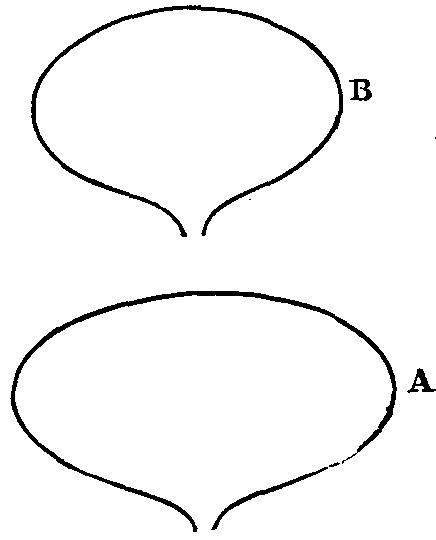
Fig. 4.
12. Thus far (and somewhat farther) I had written in Rome; but now, putting my work together in Oxford, a sudden doubt troubles me, whether all poppies have two petals smaller than the other two. Whereupon I take down an excellent little school-book on botany—the best I've yet found, thinking to be told quickly; and I find a great deal about opium; and, apropos of opium, that the juice of common celandine is of a bright orange colour; and I pause for a bewildered five minutes, wondering if a celandine is a poppy, and how many petals it has: going on again—because I must, without making up my mind, on either question—I am told to "observe the floral receptacle of the Californian genus Eschscholtzia." Now I can't observe anything of the sort, and I don't want to; and I wish California and all that's in it were at the deepest bottom of the Pacific. Next I am told to compare the poppy and waterlily; and I can't do that, neither—though I should like to; and there's the end of the article; and it never tells me whether one pair of petals is always smaller than the other, or not. Only I see it says the corolla has four petals. Perhaps a celandine may be a double poppy, and have eight, I know they're tiresome irregular things, and I mustn't be stopped by them;23—at any rate, my Roman poppy knew what it was about, and had its two couples of leaves in clear subordination, of which at the time I went on to inquire farther, as follows.
13. The next point is, what shape are the petals of? And that is easier asked than answered; for when you pull them off, you find they won't lie flat, by any means, but are each of them cups, or rather shells, themselves; and that it requires as much conchology as would describe a cockle, before you can properly give account of a single poppy leaf. Or of a single any leaf—for all leaves are either shells, or boats, (or solid, if not hollow, masses,) and cannot be represented in flat outline. But, laying these as flat as they will lie on a sheet of paper, you will find the piece they hide of the paper they lie on can be drawn; giving approximately the shape of the outer leaf as at A, that of the inner as at B, Fig. 4; which you will find very difficult lines to draw, for they are each composed of two curves, joined, as in Fig. 5; all above the line a b being the outer edge of the leaf, but joined so subtly to the side that the least break in drawing the line spoils the form.
14. Now every flower petal consists essentially of these two parts, variously proportioned and outlined. It expands from C to a b; and closes in the external line, and for this reason.
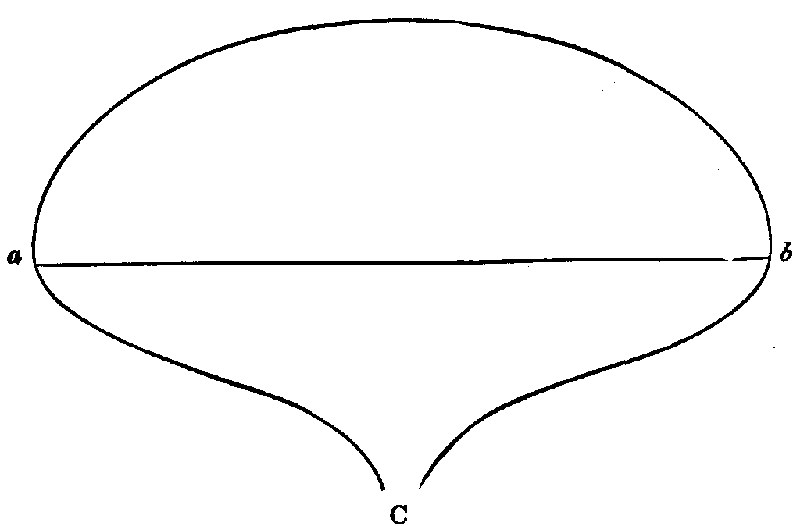
Fig. 5.
Considering every flower under the type of a cup, the first part of the petal is that in which it expands from the bottom to the rim; the second part, that in which it terminates itself on reaching the rim. Thus let the three circles, A B C, Fig 6., represent the undivided cups of the three great geometrical orders of flowers—trefoil, quatrefoil and cinquefoil.
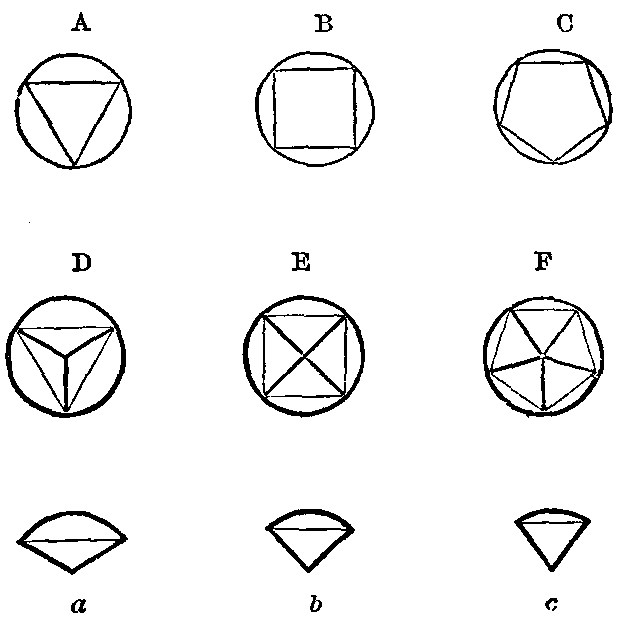
Fig. 6.
Draw in the first an equilateral triangle, in the second a square, in the third a pentagon; draw the dark lines from centres to angles; (D E F): then (a) the third part of D; (b) the fourth part of E, (c) the fifth part of F, are the normal outline forms of the petals of the three families; the relations between the developing angle and limiting curve being varied according to the depth of cup, and the degree of connection between the petals. Thus a rose folds them over one another, in the bud; a convolvulus twists them,—the one expanding into a flat cinquefoil of separate petals, and the other into a deep-welled cinquefoil of connected ones.




